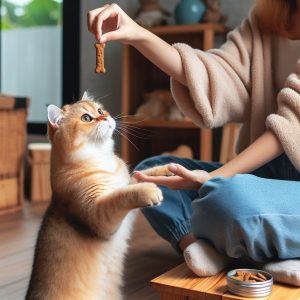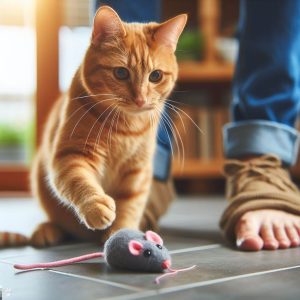Dry cat food can be tough for some cats to chew and digest properly. As cats age or have dental issues, chewing hard kibble can become painful. Kittens also need softer food that is easier on their developing teeth and jaws. Fortunately, there are ways to soften dry food to make it more palatable and digestible for cats.
Why Softening Dry Food Helps Cats
There are several benefits to softening dry cat food:
Easier chewing and eating: Cats with sore teeth or gums can find hard kibble difficult and painful to eat. Softening the food makes it easier for them to chew and swallow. This ensures they get adequate nutrition.
Better digestion: Dry food can be tough on the digestive tract, especially for younger and older cats. Soaking kibble starts the digestion process and makes nutrients more bioavailable. Cats may absorb more nutrients from softened food.
Increased water intake: Cats have low thirst drives and often do not drink enough water. Soaked food provides extra hydration, which is vital for kidney and urinary tract health.
More aroma and flavor: Many cats are more enticed to eat food with enhanced smells and tastes. Soaking dry food releases flavor and makes it more aromatic.
Transitioning food: When transitioning to a new food, gradually softening the old food and mixing it with the new food helps avoid an upset stomach.
Picky eaters: Some finicky felines refuse crunchy kibble but will eat it when it’s softened. This ensures picky cats still get balanced nutrition.
When to Soften Cat Food
There are certain situations when softening dry cat food can be particularly helpful:
Kittens: Kittens do best with softened food as they transition from nursing to solid foods. The softer consistency is easier for them to chew and digest.
Pregnant or nursing cats: Soft food provides extra hydration and nutrition for mom cats with increased caloric needs.
Senior cats: Older cats often have dental disease and weakened digestion. Softened food is gentler on their teeth and guts.
After surgery or illness: Cats recuperating need easily digestible nutrition. Soaking food makes it gentler on the stomach.
Cats with digestive issues: Conditions like IBD or food sensitivities respond well to softened, easy-to-digest food.
Cats with kidney disease: The extra moisture in soaked food supports kidney function and hydration status.
Cats with dental disease: Soft food reduces pain from damaged teeth and gums.
New adoptees: Shelter cats adjusting to a home do well when gradually transitioned to new food textures.
How to Soften Dry Cat Food
Softening dry cat food is easy using a few simple methods. Here are some tips for making crunchy kibble easier to eat:
1. Add Warm Water
The most straightforward way to soften dry food is by adding warm water. Follow these steps:
- Place the kibble in a microwavable bowl. Use about 1/4 cup water per 1/2 cup of food.
- Heat the water in the microwave for 15-30 seconds until warm but not scalding hot.
- Pour the water over the kibble. Let it stand for 10-15 minutes to fully soften.
- Stir well before serving to your cat.
The warmth helps release aroma and makes the food more enticing. Make sure the water is not too hot to avoid hurting your cat’s mouth.
2. Use Chicken or Vegetable Broth
For extra moisture and flavor, use chicken broth or vegetable broth instead of plain water:
- Choose low-sodium varieties to minimize salt content.
- Heat the broth for 15-30 seconds in the microwave until warm.
- Mix with dry food as directed above.
- Let stand 10-15 minutes before serving.
Broths add a tasty scent and supplemental nutrition to excite finicky eaters.
3. Microwave Kibble Directly
You can simplify the process by microwaving kibble directly with no added liquid:
- Place kibble in a microwave-safe bowl. Use about 1/4 cup per cat.
- Microwave for 10-15 seconds. Check and stir.
- Microwave for another 5-10 seconds if still too firm.
- Allow to cool briefly before serving.
Microwaving makes kibble pliable and releases the food’s aromas. Take care not to overcook.
4. Soak in Warm Water
For an even softer consistency, soak kibble in warm water for 5-10 minutes before serving:
- Place dry food in a bowl.
- Boil water and let cool for 1-2 minutes until no longer simmering.
- Pour the warm water over the kibble. Use roughly 1/4 cup water per 1/2 cup food.
- Let soak 5-10 minutes until thoroughly moistened and expanded.
- Drain any excess water before feeding to your cat.
Soaking fully hydrates the food and makes it significantly softer and easier to chew.
5. Make a Soup or Stew
To transform dry food into a savory soup or stew, simmer kibble with added ingredients:
- Place kibble in a small saucepan. Cover with broth, milk, or water.
- Add shredded chicken, fish, or a few spoonfuls of canned cat food.
- Simmer over low heat for 10-15 minutes, stirring frequently.
- Remove from heat and let stand 5 minutes before serving.
The simmering action infuses flavor and moisture to create a tasty meal.
Foods to Avoid Soaking
Most dry cat foods can be softened, but avoid soaking these varieties:
- Prescription foods: Only soak if your vet confirms it is safe to do so.
- High-protein, grain-free: Extremely high protein can be harsh on the kidneys when soaked.
- Coated kibbles: The coatings may become slimy or dissolve when wet.
If unsure, check with your veterinarian before soaking prescription or therapeutic foods. For high-protein kibbles, soak separately and mix with other wet foods instead of water.
Transitioning Your Cat to Softened Food
Sudden food texture changes can upset your cat’s tummy. Transition gradually when introducing softened food:
- Mix a little: On the first day, mix a teaspoon of softened kibble into your cat’s usual crunchy portion.
- Increase slowly: Add a bit more softened food every 1-2 days, reducing the regular kibble.
- Take your time: It can take 1-2 weeks to fully transition your cat to only eating softened food. Go slow and watch for signs of digestive upset.
- Persist if picky: Your cat may resist the new texture at first. Stick with the gradual transition until they accept softened food.
Patience and persistence are key when shifting your feline to softened chow. Give your cat time to get accustomed to it.
Best Practices for Feeding Softened Food
Follow these tips to safely feed softened dry cat food:
- Soften only what your cat will eat in one meal. Refrigerate or discard any leftovers.
- If adding liquid, use warm or room temperature—not piping hot. Let soaked food cool before feeding.
- Discard any uneaten portions after 30 minutes. Do not leave wet food out for hours.
- Ensure bowls and utensils are clean when preparing softened food.
- Wash food prep surfaces thoroughly after use.
- For young or reluctant eaters, consider warming the soaked food slightly to enhance aromas.
- When reheating, use short 10-15 second bursts in the microwave to prevent overheating.
- Consult your vet if your cat refuses to eat or has diarrhea after transitioning to softened food.
Proper handling and hygiene practices are important when working with moistened cat food.
Storing Softened Cat Food
Soaked cat food has a shorter shelf life than dry kibble. Follow these storage guidelines:
- Refrigerate soaked food if your cat will not eat it all promptly. Discard any unused leftovers after 24 hours.
- For refrigerated storage, place soaked portions in sealed containers to prevent drying out. Glass or plastic containers with lids work well.
- Do not freeze soaked cat food. The texture will suffer when thawed.
- Any reheated food should be consumed immediately. Do not re-refrigerate or re-freeze.
- When reheating, use the microwave or stovetop to warm food. Avoid getting it piping hot.
Proper, covered storage is key to preserving the moisture content and freshness of hydrated cat food. Refrigerate promptly for best quality.
Signs Your Cat Needs Softer Food
Watch for these signs that your feline may benefit from softened kibble:
- Difficulty chewing dry food – Your cat eats slowly, swallows chunks whole, or vomits up kibble.
- Loss of appetite – Previously ravenous cats start disinterestedly picking at their food.
- Weight loss – Your cat’s weight drops since eating hard food became difficult.
- Excessive salivation – Drooling or watery mouth while eating may signal oral pain.
- Bad breath – Foul breath can indicate advanced dental disease making chewing painful.
- Excessive vomiting or constipation – Hard food may not be digesting well.
- Increased vocalizing – Meowing or yowling when fed can mean mouth discomfort.
- Hesitance jumping or reluctance moving – Dental or joint pain while crunching food.
If you notice any of these, consult your vet and try softening your cat’s dry food to see if it provides relief. Their input can help determine if an underlying health issue needs treatment.
When to Talk to Your Vet About Softened Food
Check with your veterinarian before softening food if your cat:
- Has a confirmed diagnosis requiring a therapeutic veterinary diet
- Is currently unwell or recovering from an illness
- Has undergone recent surgery or medical treatment
- Is elderly or suffers from kidney disease or diabetes
- Has experienced gastrointestinal upset or diarrhea after adding moisture to food
- Is severely underweight and unable to maintain healthy body weight
Vet consultation ensures adjusting your cat’s food moisture and texture will not interfere with any treatment plans or prescribed diets. Your vet can also rule out other conditions causing eating difficulty.
Nutritional Considerations With Softened Cat Food
There are some nutritional factors to keep in mind when serving softened dry food:
Lower caloric density – Soaking food can dilute caloric content slightly. Monitor your cat’s body weight and adjust portion sizes accordingly.
Increased carbohydrates – The extra water leads to relative increased carbs versus protein. This may impact cats needing high protein therapeutic diets.
Higher water content – Cats fed only softened food need to drink less water separately. But be sure some separate fresh water is always available.
Possible loss of nutrients – Some vitamins like thiamine can leach out into soaking water over time. Limit soaking time to 20-30 minutes.
Digestibility changes – Softening aids digestion but also increases overall food’s glycemic index. This may matter for diabetic cats.
Discuss any dietary concerns with your veterinarian when planning long-term feeding of soaked food. They can advise you on ensuring optimal nutrition.
Best Dry Cat Foods for Softening
Any dry cat food can be softened, but certain kibbles work especially well. Look for foods with:
- Small, easily softened bits, avoiding large chunky kibbles
- Some grain and fiber to help absorb moisture and improve texture
- Savory coatings and aromas that get released with hydration
- Loaf or patty formulations that soak up liquid into a gruel
- Highly palatable ingredients to tempt finicky felines
Some top-rated dry cat foods for softening include:
Royal Canin Aging 12+ – Small kibbles soaked into a pâté.
Purina Pro Plan Focus Kitten Chicken & Rice – Tiny crunchy bits swell into a moist mush for kittens.
Iams Proactive Health Indoor Weight & Hairball Care – Gravy and broth soak into the shredded bits.
Merrick Purrfect Bistro Grain-Free Senior – Ultra small, square bites with senior nutrition.
Blue Buffalo Basics Limited Ingredient Turkey & Potato – Limited ingredients ideal for cats with food sensitivities.
Check your cat’s preferences and consult your veterinarian to pick the optimal food. Proper nutrition is vital, whether served crunchy or soaked.
FAQs About Softening Dry Cat Food
Q: Is it safe to soak prescription cat food?
A: Contact your vet before soaking therapeutic veterinary diets, as the extra moisture could impact medical effectiveness. Never soak food without your vet’s approval.
Q: Should I soak grain-free cat food?
A: Grain-free and high protein kibbles can be soaked but mix with other wet foods instead of water alone. Too much added moisture stresses kidneys with such dense nutrition.
Q: Can I use hot water to soften food?
A: Avoid hot water, as it could burn your cat’s mouth. Warm water is fine but let food stand 5-10 minutes to cool before feeding.
Q: Is softened food okay for diabetic cats?
A: Discuss with your vet first. Soaking raises the glycemic index, which could impact blood sugar regulation. Monitor closely and adjust insulin with your vet’s guidance.
Q: How long can I store softened cat food?
A: Soaked cat food should be refrigerated and used within 24 hours. Discard any leftovers after 24 hours. Do not freeze or reheat soaked food more than once.
The Takeaway on Softening Dry Cat Food
Softening crunchy kibble makes it easier for cats to chew and digest while still providing complete and balanced nutrition. The extra moisture released by soaking or warming dry food adds taste, eases eating, and provides supplemental hydration to benefit cats’ health.
Use simple techniques like adding warm water or broth and allow time for food to absorb the liquid. Gradually transition your cat over 1-2 weeks when introducing softened food. Refrigerate leftovers and maintain safe handling practices for optimal freshness and food safety.
Discuss softening food with your vet if your cat has any medical conditions, takes prescription diet, or experiences digestive upset from the change. When prepared properly, serving softened dry food can make mealtimes more pleasant and nutritious for your feline companion.



